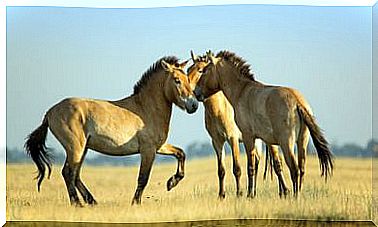Orca: Characteristics, Behavior And Habitat

The orca (Orcinus orca), also known as the killer whale , is one of the best known cetaceans still living on the planet. It has an undeserved reputation as a dangerous animal and a fascinating behavior, which is manifested in its hunting strategies. Let’s get to know her better together thanks to this article.
Characteristics of the Orca
This beautiful cetacean is an odontoceto , which means it is a toothed marine mammal, like dolphins. In fact, they belong to the same family: we can safely say that the orca is the largest dolphin in the world.
Killer whales have a very streamlined body despite their high weight. In males, this can reach 5.5 tons, while females are “lighter” and only reach 4 tons. In addition to being heavier, the male specimens have a larger dorsal fin, which even reaches 2 meters.
These animals are unmistakable due to the black and white coloring of their body. Orca stains are unique to each individual (a bit like how it works for human fingerprints). These marks can be used in many studies and help researchers distinguish different specimens.
Killer whales are very long-lived animals , although mortality is very high during the first 6 months of life. For this reason, their average life expectancy does not exceed 30 years. However, once they have passed their juvenile stage, they can live up to 90 years and most adult killer whales reach the average age of 60.
Habitat
This species has an enormous distribution in the world’s oceans, having been found in most of the world’s seas. In fact, it is the cetacean with the highest distribution. The coasts of the Arctic, Russia, Japan, South Africa, Australia or Spain are just a few examples of their extreme ecological success.
There are different populations of killer whales that have adapted to different habitats . Many of them often migrate, as a result of climate change and, above all, with the displacement of fish and other prey (such as seals) that these toothed cetaceans feed on.
This widespread diffusion makes it very difficult to estimate the number of killer whales that exist. According to the latest data collected, the world population of killer whales is at least 50,000 specimens. But, given that there are no censuses capable of mapping their real presence in every sea of the world, this value could be much higher. But be careful: even these living beings are increasingly threatened by the pollution that affects the oceans.
Behavior
Killer whales form complex social structures, where the offspring is defined by the maternal line. That is, family unity is ensured by several generations of females.

They are animals that form strong social bonds, similar to those of great apes or elephants. They can form very large groups of even 100 individuals, but on average groups of about 10 members are sighted.
To communicate, these large marine mammals use a different language depending on the area in which they are found. These are, therefore, real dialects that the researchers were able to record, distinguishing a wide variety of signals. Just like it happens in dolphins.
Two killer whales from two different parts of the world may not understand each other, although it has been observed that they can learn dialects from others, since these languages are culturally transmitted.
Killer whale hunting strategies
Culture is the set of knowledge that a species can transmit from generation to generation. Like the dialect , the hunting strategies of killer whales also differ from area to area of the planet.
All of these strategies are characterized by collaborative behaviors between clan members. This allows them to overwhelm even some of the largest animals in the world, such as the blue whale.
For example, in the Scandinavian fjords, killer whales hunt herring by circling the shoal, creating a whirlpool and waves that cause the small fish to lose their bearings.
Other times they spray jets of air at their prey, stun them by hitting them with all the strength of their powerful body or even by emitting very loud acoustic signals. Eventually, they poke the group of fish with their tails to be able to consume the ones that don’t recover. Another system, used against penguins and seals, is to swim under the ice islets and drop the animals into the water when they least expect it.
In the Mediterranean, killer whales have been seen stealing food from fishermen. They take advantage of the boat that raises the nets full of fish to snatch away the succulent booty. A curious story is that of the famous Old Tom ( Old Tom ), an orca who helped Australian whalers to fish in the open sea.
In Argentina, killer whales flock to the Patagonian coast to catch sea lions and penguins, who don’t expect to be hunted to land. In the seas near Gibraltar, they hunt the delicious bluefin tuna, chasing it for miles and driving it to exhaustion.
As you can see, killer whales are gifted with truly amazing intelligence. Not only are they fascinating animals and they all leave you with bated breath when they jump into the ocean. The fact that they communicate with their own language and are aware of their behavior makes them very interesting beings.









